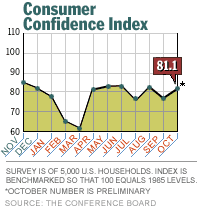NEW YORK (CNN/Money) -
When Wal-Mart talks about consumers, economists listen.
And the remarks the world's biggest retailer made Thursday about consumers, who fuel most of the world's biggest economy, raised fears that an expected fourth-quarter slowdown in spending could be steeper than expected.
In announcing third-quarter earnings that missed Wall Street estimates, Wal-Mart (WMT: down $0.70 to $54.82, Research, Estimates) CEO Lee Scott also warned that consumers weren't exactly stampeding over Wal-Mart's greeters to spend money.

"I don't think consumer spending is slowing, but I don't see the strength many of you in the investment community appear to see," Scott said in a conference call. "We're seeing cautious customers ... timing their expenditures around the receipt of their paycheck, indicating liquidity issues."
While Scott might have been playing possum to some degree, trying to keep investor expectations for the holiday season low, his comments nonetheless raised some economists' eyebrows.
"It's a red flag. Any time the nation's largest retailer stumbles a bit, it's a warning sign," said Douglas Porter, senior economist at BMO Nesbitt Burns.
Wal-Mart's outlook was echoed by Target (TGT: Research, Estimates), the nation's No. 2 discount retailer, which warned it could miss fourth-quarter earnings estimates, saying stiff retail competition could hurt holiday sales at its Marshall Field's and Mervyn's department stores.
| Related stories
|

|
|
|
|
Luxury retailer Tiffany (TIF: Research, Estimates) joined the chorus late Thursday, offering a somewhat disappointing outlook -- to Wall Street, anyway -- for the holiday season.
And Friday'sretail sales report from the Commerce Department showed a bigger decline than expected in October, though that was due to a fall-off in automobile sales, and economists saw some encouraging signs in the underlying data.
"Santa's workshop will be operating pretty much at full capacity," said Bill Cheney, chief economist at John Hancock Financial Services in Boston. "There just probably won't be much elf overtime."
Though hopes have been high for a decent holiday spending season, few economists expected consumers to turn in a fourth-quarter performance to match the third quarter, when their spending grew at an annualized rate of 6.6 percent, the fastest pace in six years.
Most economists think continuing improvement in business spending, driven by a need to re-stock depleted inventories, will help the economy post decent growth in the fourth quarter.
But consumer spending is still the 800-pound gorilla of the U.S. economy, and signs of consumer weakness are wholly unwelcome, suggesting there could be a lot of Scrooges poking around the malls this holiday season.
"Consumers right now are bargain hunters, and that's what Wal-Mart is talking about," said Delos Smith, senior economist at the Conference Board, a private research firm that publishes a monthly survey of consumer confidence. "If you're offering a bargain and the consumer thinks it will go away, you'll get the consumer to buy, but there is no impulse buying going on."
Confidence, wage growth stagnant
Certainly, consumers almost never stop spending -- people always need to eat, gas up the Ferrari, and put clothes on their backs. There hasn't been a downturn in the Commerce Department's consumer spending data since 1991, and nobody expects one in 2003.
Still, Wal-Mart CEO Scott said a significant boost to consumer spending wouldn't come until the long-suffering labor market improved more. Though the economy added 251,000 new jobs in September and October, according to the latest Labor Department data, that's not enough to keep up with the natural growth of the labor force, and it hasn't yet translated into a rebound in consumer confidence.
Measures from the Conference Board, the University of Michigan and ABC and Money magazine have all been stagnant, despite recent good economic reports.
"We're still in a seasonally weak period of year, where companies are trimming workforces," said Gary Thayer, chief economist at A.G. Edwards. "It weighs on people's minds when they hear about companies cutting back."
The sluggish recovery of the labor force has also kept a lid on wage growth; average hourly earnings grew just 2.4 percent in the past 12 months, according to the Labor Department, the slowest rate since 1994.
Using the Commerce Department's measure of wages and salaries, income growth has been even slower, rising just 2 percent since the third quarter of 2002 -- a rate that doesn't even keep up with the 2.3 percent growth in the Labor Department's consumer price index in the past year.
But the tax cuts and child tax credit rebates passed this year by President Bush and Congress, along with a flood of cash from cash-out mortgage refinancings, helped consumers ignore weaker wage growth in the third quarter.
Though the effects of those booster shots are disappearing in the fourth quarter, many economists note that consumer spending should get another push from tax cuts in the first half of 2004. This year's tax cut was retroactive to Jan. 1, but new withholding rates didn't take effect until July, meaning many consumers will get a bigger-than-usual refund check in the spring.
According to bond market analyst Anthony Crescenzi of Miller, Tabak & Co., citing White House figures, consumers should end up with an extra $100 billion in the first half of 2004, much of which, he believes, will go straight to retailers.
"It would be a mistake to get bearish on the consumer now," Crescenzi said. "It's been a mistake to be bearish on the consumer for many years."

|

